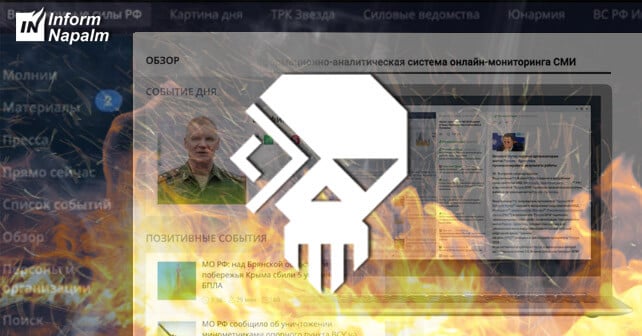By InformNapalm
Ukrainian hacktivists of the Cyber Resistance group penetrated the Department of Information and Mass Communications of the Russian Ministry of Defense (DIMC) and handed over unique internal documentation and provided access to the software used by Russian military propagandists to InformNapalm volunteer intelligence community.
The DIMC is the realm of the notorious Igor Konashenkov, the spokesperson who is daily voicing Russian reports from the combat zone. In the Ukrainian eyes, Igor Konashenkov has long become a walking meme, as it was, he who day after day rattled out the phrase “there are no losses” during the first weeks of the invasion and claimed thousands of destroyed Ukrainian tanks – more than Ukraine had before the invasion.



But such a contrived parallel reality created by reports from the Russian Defense Ministry, is not a figment of the Konashenkov’s imagination alone. The retrieved documentation makes it clear how removed from the real state of affairs the entire Information Department of the Russian Defense Ministry is.
Employees of the department and the press services of the Russian military districts and fleets under its control constantly analyze the Russian information space. Everything that is directly or indirectly related to news about the activities of the Russian Armed Forces is reflected in various reports. Moreover, publications in foreign media are analyzed separately.
This is what the daily media review looks like:
- Daily media review (11/13/2023). [PDF RUS]
Here is an overview of how the aggressor army is covered in the foreign media:
- Russian Armed Forces in foreign media 2023-11-13. [PDF RUS]
The department also prepares detailed daily reports with transcripts of all propaganda reports for the day:
- Media review (digest) 2023-11-13. [PDF RUS]
We wonder who proofreads all this, because at times the texts look really cringy. It seems that Russian propagandists themselves do not read very closely into what they write. For example, they call their military personnel “military prisoners” [Ed.: “военнопленные” instead of “военнослужащие”].
Every week, Colonel Kochetkov submits a report on the scope of materials released and the reaching of targets to Konashenkov for approval.
- Report for the November 11, 2023 meeting. [DOCX RUS]
And later, another clerk of this department, Sergei Tovpeko, sends out this document along with the planned information events in the Russian Armed Forces for the next week and a weekly report on the print media to all the heads of press services of the military districts, service branches, fleets, etc.
- Print media from November 4 to 10, 2023. [DOCX RUS]
- Main_topics_in the Russian Armed Forces from November 13 to 19. [DOCX RUS]
Special software suite KATYUSHA
It is no secret that Russia has total control over its information space. Such control needs constant monitoring. And as we see in the reports produced by the DIMC, they sift through colossal amounts of information. Therefore, they use special software to collect media data for their reporting.
This software is the information and analytical system for online media monitoring KATYUSHA.

Cyber Resistance hacktivists gained access to this system and were able to study its features.

Katyusha is a Russian counterpart of SemanticForce media monitoring system.
It was developed by the private company M13. They claim to specialize in information technology in the field of media monitoring, offering three systems: ARSENAL, ARENA and KATUSHA. Their software is used by the Russian presidential administration, the government, federal ministries and departments, regional government executive agencies, commercial companies and public organizations. In 2021, the Russian Ministry of Defense bought a license to use Katyusha, allocating 320 million rubles for this until 2023 inclusive.
What does Katyusha offer?
- Media monitoring 24/7. According to the developer, the database covers 40,000 sources: Russian federal and regional media, Russian-language and “key” media abroad,
- options to sort information by time, topics, headings, named objects and types of media,
- assessment of information based on sentiment and audience coverage,
- monitoring of key Russian print media,
- monitoring of both traditional and new (social) media,
- displaying the main information events of the day, week or selected period,
- detection of coordinated information attacks.
This is what the developer declares. However, the research of Katyusha by hackers showed its true capabilities. The system displays events and messages by category (at the top), for example, for Zvezda, the media company of the Russian army:

Or foreign media writing about the Russian army:

Weekly and monthly reports are uploaded by the system:

The circulations of the largest Russian print media are added to the system daily:

The first tab “Russian Armed Forces” has richer options for analysis, and messages are immediately marked by sentiment – positive (green), negative (red), neutral (yellow). Here, it is possible to view relevant publications and events (i.e. news with the highest citation index), make searches by persons and organizations (the system pulls in related news reports).




Of course, Russians pay special attention to social media. The system pulls in posts published on Telegram, VK, OK, LiveJournal and the like in real time. Facebook and Instagram also have a presence, although insignificant. YouTube videos are also pulled in. We have also noticed some Ukrainian channels there, which were earmarked by the Russian system.


The system also has an interesting tab with an analysis of popular Russian Telegram channels. They are explicitly sorted into positive and negative. Why this has been done will be discussed later.

The system also runs statistics on publications and mentions of individuals and organizations for the selected period.


However, analyzing this system, we came to the conclusion that Katyusha is a kind of window dressing tool. Obviously, the DIMC uses it for reporting. However, the system clearly misrepresents the sentiment. Negative reports about the Russian army, military and political leadership of the Russian Federation are either disregarded or marked as neutral. The system is programed to whitewash the reality – no negative reporting about Putin or the army, no failures. A kind of digital Konashenkov – “there are no losses.”
The system analyzes mainly the Russian information space. Western and Ukrainian media are present in the database, but they must be searched manually. They do not affect the overall picture. Any analysis is predominantly based on the Russian sources, which are subject to censorship and self-censorship. Accordingly, the value of such a system is in reflecting the state of the Russian information space: an extensive network of controlled media, coordinated media campaigns, total censorship (and even more self-censorship). In short, mapping a parallel self-congratulatory reality constructed by the domestic media.
Yes, the system also sees negative news reports. However, for one “negative” report, the extensive Russian propaganda machine throws in dozens of “positive” ones, effectively switching attention and shifting emphasis. After the successful Ukrainian strike on the headquarters of the Russian Black Sea Fleet on September 22, we personally watched online how the Russian propaganda machine quickly reacted, adapted on the fly and then totally twisted the meaning of the event.
KONASHENKOV LETTER
Cyber Resistance hacktivists also found and handed over to InformNapalm an interesting document – a letter from Konashenkov to Shestakov, Deputy General Director of All-Russia State Television and Radio Broadcasting Company (Russia-1, Russia-24 TV channels).

This letter is interesting because it mentions some “unreliable” Russian Telegram channels. Unfortunately, the hacktivists could not obtain the attachment with the list of these channels. However, another look into Katyusha gives us a good idea of what Konashenkov’s list was.

As evidenced by the internal system of the DIMC, military propagandists of the Russian Ministry of Defense are already distinguishing between reliable and unreliable channels on Telegram. And there is certain logic to it. Both groups contain mostly pro-war channels, but some are more loyal to the Russian political leadership, some are less, and uniformed propagandists are taking notice of the rift. For example, on November 16, Putin awarded the founder of the Rybar Telegram channel, Mikhail Zvinchuk, the Russian Order For Merit to the Fatherland, II class. The Rybar channel is well regarded as “reliable” by the Russian propaganda machine and is listed in the system accordingly.
As reported by the Russian “opposition” media, in October 2022, at the request of Valeriy Gerasimov, Roskomnadzor and Russian law enforcement agencies began checking the content of the Russian war correspondents for “fakes” and “discrediting” the Russian army. This was followed by the arrest of Igor Girkin who had become a vocal critic of the Russian political leadership for its insufficiently hardline approach to the war.
It looks like now, in the run-up to Putin’s elections, Russian law enforcement agencies are beginning the last wave of purging Telegram of any disloyalty to the Kremlin.
On November 13, we all observed strange convulsions in the Russian media with the statement of the Dnieper group of Russian forces about another “goodwill gesture” (aka retreat) in the Kherson Oblast. Leading Russian media published and then a few minutes later “annulled” the relevant news report (another example of the Russian newspeak). Then dozens of experts and analysts puzzled over what had just happened. The Ukrainian side then stated that this was a Russian PSYOP, and there was no evidence of any preparations by the Russians to retreat.
We tend to share this opinion with only one reservation. This special operation was not aimed against the Ukrainian side as such. On the contrary, it was an attempt by the Russian Ministry of Defense to draw out disloyal Telegram channels tending towards critical coverage. The likes of the Two Majors channel, where it is easy to find critical content. Despite being another war propaganda outlet, it is listed under “unreliable” in the Katyusha system.


If you look at Konashenkov’s letter, it is dated November 14. The outlandish statement about the retreat of the Dnieper group of forces was published and “annulled” on November 13. What is this if not a provocation? Nothing and no one can stop Putin from triumphantly winning elections in silence. Dictatorships do not tolerate dissent.
Therefore, already on November 17, Russia is strengthening control over the Internet, which, according to the ISW analysts, is another manifestation of censorship and an attempt to limit free access to information in a bid to “control” Putin’s elections. And later ISW opined that Shoigu’s statement at the Defense Ministry meeting on November 21 is believed to be an attempt to downplay the concerns of some Russian milbloggers about Russia’s inability to decisively repel Ukrainian attacks on the east bank of the Dnipro river. Analysts, however, doubt that these statements will quell the complaints spreading in the Russian information space.
Of course, we would all like to believe in the retreat of the Russians on the east bank. But we definitely don’t want to be part of their information games. So, let them squabble among themselves. In the meantime, the Ukrainian army is fighting valiantly to bring closer the real retreat of the Russians from the occupied territories of the Kherson Oblast, whereas Ukrainian hacktivists, having penetrated Konashenkov’s propaganda systems, promise many more surprises.
By InformNapalm






